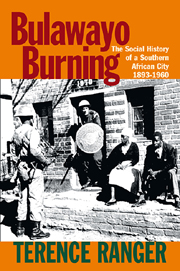Book contents
- Frontmatter
- Contents
- List of Illustrations
- Introduction
- Prelude: Bulawayo, 1893–1930
- 1 The Landscapes of Bulawayo
- 2 The First Fires: December 1929
- 3 City versus State 1930–1946
- 4 Mr Black Bulawayo 1930–1948
- 5 The Feminization of Black Bulawayo 1948–1960
- 6 Black Bulawayo Transformed
- 7 Black Bulawayo Burns 1960
- Postlude: Bulawayo after 1960
- Selected Bibliography
- Index
1 - The Landscapes of Bulawayo
Published online by Cambridge University Press: 05 April 2013
- Frontmatter
- Contents
- List of Illustrations
- Introduction
- Prelude: Bulawayo, 1893–1930
- 1 The Landscapes of Bulawayo
- 2 The First Fires: December 1929
- 3 City versus State 1930–1946
- 4 Mr Black Bulawayo 1930–1948
- 5 The Feminization of Black Bulawayo 1948–1960
- 6 Black Bulawayo Transformed
- 7 Black Bulawayo Burns 1960
- Postlude: Bulawayo after 1960
- Selected Bibliography
- Index
Summary
The chapters which follow describe a series of more or less dramatic events. This chapter sets the scene for them by laying out the landscapes in which they took place. Southern African urban landscapes have received little attention from historians. Yet a major theme in the social history of white Bulawayo in the 1930s is the interaction of the town with a number of different surrounding landscapes. A major theme in its intellectual history is the development in Bulawayo of ideas of ‘wilderness’ and ‘countryside’; ideas of rural, suburban and urban beauty. The creation of a black Bulawayo urban identity, moreover, was also linked to African ideas of ‘the country’ and of its relation with the town. These questions of landscape cannot be left out of urban history without seriously impoverishing it.
A City in the Wilderness: The Self-image of White Bulawayo in the 1930s
I have already described some of the tensions of the year 1929 in Bulawayo – the white rail strike and its repression; the lynch mob; the apprehension aroused by the ICU. Nevertheless, that August white Bulawayo was at its most urbane. Its annual Agricultural Show coincided for the first time with a Motor Show, the Caledonian Society Ball, a cabaret at the Grand Hotel, a local production of the musical ‘Hit the Deck’, and with Tarzan and Gary Cooper at the cinema. There were intellectual attractions too. No fewer than 380 scientists were due in Bulawayo from the British Association meeting in Johannesburg. Some of them were to lecture in the town on topics as diverse as ‘Scientific Agriculture’ and the meaning of rock paintings.
- Type
- Chapter
- Information
- Bulawayo BurningThe Social History of a Southern African City, 1893–1960, pp. 53 - 82Publisher: Boydell & BrewerPrint publication year: 2010



